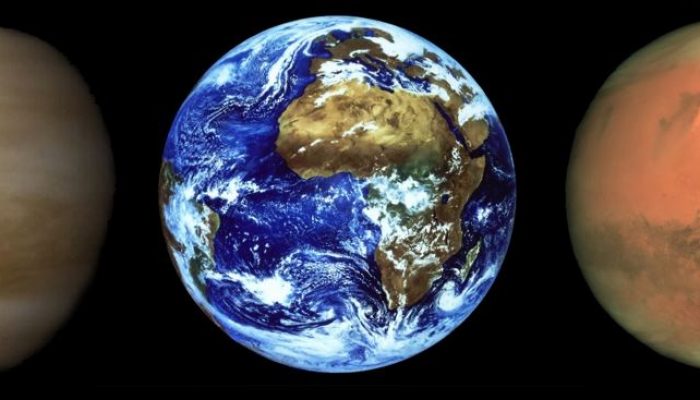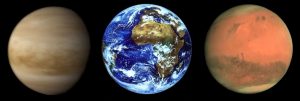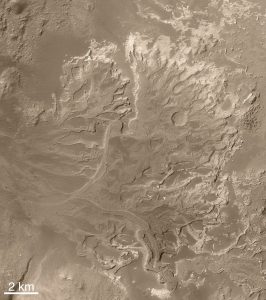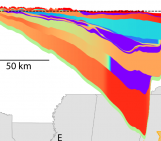
Post by WaterUnderground contributors Elco Luijendijk and Stefan Peters from the University of Göttingen, in Germany.
After my first ever scientific presentation, someone in the audience asked a question that caught me off guard: “Where does the groundwater come from?”. “Ehm, from rainfall”, I answered. The answer seemed obvious at the time. However, we did not realize at the time that this is actually a profound question in hydrogeology, and one that is rarely addressed in hydrology textbooks and courses: “How did our planet get its water?”. To find out how far science has come to answering this question I (EL) joined up with a geochemist and meteorite expert (SP) to write this blog post.
We are lucky to live on a planet of which ~71% of the surface is covered with water, located mostly in rivers, lakes, glaciers and oceans at the surface and as groundwater in the shallow subsurface. Liquid water sustains life on our planet and seems to play a critical role in plate tectonics. And incidentally, it also to gives hydrogeologists something to study. Liquid water is so important in sustaining life, that the search for life on other planets in our solar system or beyond always focuses first on finding planets with liquid water.
Not only do we have abundant liquid water, we seem to have just the right amount. Compared to our direct planetary neighbors, Mars and Venus, we are extremely lucky. On the surface of Mars, at present, water mainly occurs as ice, whereas tiny amounts of water vapor are present in the Martian atmosphere. Venus also has minute amounts of water vapor in the atmosphere, but its blazingly hot surface is entirely devoid of water. In contrast to Mars and Venus, some objects in the solar system that are further away actually have too much water. Take for instance Enceladus, a moon of the planet Saturn, at which an icy crust overlies a 10 km deep water ocean. The amount of water on Enceladus is so large that it causes a wobble in the rotation of this moon, which is one of the reasons why this large volume of water was discovered in the first place. Clearly Enceladus is great for ice-skating, but probably not for sustaining land-based life similar to humans.

Figure 1: From left to right, Venus, Earth and Mars. Which one would you like to live on? Source: ESA (link) .
So how did we on Earth get so lucky?
It turns out that this depends on which scientist you ask. There are two theories:
Theory 1: The major building blocks of the Earth contained water from the start. This water then accumulated at the surface of our planet (by “degassing” from the mantle) and formed the oceans and the hydrosphere.
Theory 2: The major building blocks of the Earth were bone dry, and most of the water was delivered by comets and water-rich asteroids some time after most of our planet’s mass had formed by accretion.
So far, scientists do not have reasons to discard either of these theories, but there are two important arguments in favor of water being delivered after most of the planet had already formed:
Earth formed in a hot region of the solar system from which molecules with “low” condensation temperatures such as water had largely been removed before planetary accretion started (Albarède, 2009). Secondly, the ratio of heavy to light water in Earth’s oceans is similar to that of water in some comets and asteroids (Hartogh et al., 2011). Although you may not have noticed this when you last opened your water tap, a very small fraction (0.016 %) of the water on our planet is heavy, because it contains an extra neutron. The similarity in heavy water composition between asteroids and comets and Earth’s oceans does not prove that water on Earth was delivered by comets, but it certainly is consistent with this scenario. To make matters more complicated, however, the recent European space agency mission Rosetta to the water-rich comet 67P/Churyumov–Gerasimenko found that it has a very different ratio of heavy to light water than our oceans, which certainly complicates the debate.

Figure 2 Comet 67P/Churyumov-Gerasimenko losing water (and dust) as it gets closer to the sun. Source: ESA
Interestingly, neither theory can directly explain why our direct planetary neighbors, Mars and Venus, are so dry compared to Earth. So is it possible that these planets once were similar to Earth, and contained more water in their early days than that they do now?
Due to the high surface temperatures at Venus, any liquid water near the surface would immediately evaporate and diffuse into the atmosphere of the planet as a gas. We know that due to the lack of a protective magnetic field on Venus, solar winds continuously erode the atmosphere of the planet. If Venus had abundant water in the past, such erosion by solar winds would therefore have effectively stripped water from the planet’s atmosphere. Similar to Venus, Mars also does not have a protective magnetic field, but the temperatures and pressures at the Martian surface are significantly lower than at Venus’ surface, allowing water to be present at the surface as ice. In fact, Mars may have had a denser atmosphere in the past that allowed liquid water to be present at the surface. Nowadays, erosional features such as channels are the dry witnesses that water indeed once occurred as a liquid on the surface of the planet.

Figure 3. Dry channels (in inverted relief) in the Eberswalde delta on Mars as seen by NASA’s Mars Global Surveyor (link)
As a summary, we have an idea on why our planet was lucky enough to keep large amounts of water compared to Venus and Mars. However, do we know how our planet got its water in the first place? Unfortunately we are still not sure. There is hope though: we keep getting closer to the answer thanks to recent research on the composition of water on our planet and comets and asteroids in the solar system. So stay tuned, there’s a good chance that science will be able to answer this question in the coming years…
References
Hartogh, P. et al. (2011), Ocean-like water in the Jupiter-family comet 103P/Hartley 2, Nature, 478(7368), 218–220.
Albarède, F. (2009). Volatile accretion history of the terrestrial planets and dynamic implications. Nature, 461(7268), 1227-1233.




